It had been two years since my previous back pack trip into this amazing part of the Alpine National Park (See post – Stalking Sambar with a Camera, Sept 2014).

Doug, my brother-in-law, joined me on this trip. Doug, like me, enjoys bush walking and outdoor adventure. This was an opportunity for Doug to see Sambar in a scenic and rugged landscape. He was keen to take his firearm with him as part of the experience. Being physically fit and feeling at ease in a remote area away from roads and tracks is a pre-requisite for this type of activity. It does not appeal to everyone. There are risks and hazards with potential for slips, trips and falls. We took it slowly when negotiating rocks, steep slopes and loose ground. It helps if you are sure footed with a good sense of balance. If you sprain a knee or ankle it would be extremely tough going to get back to the car. We did some fitness training leading up to this trip including an overnight walk with all our gear. This also helped us test our equipment and explore ways of keeping our pack weight down to a minimum. Lugging in a big lens and tripod wasn’t easy for me but I suppose it’s akin to Doug taking his firearm. Our intention was to be away from the car for five days so planning for food and provisions was important. Water was scarce on the way in so we had to carry sufficient water to last for a day or more.
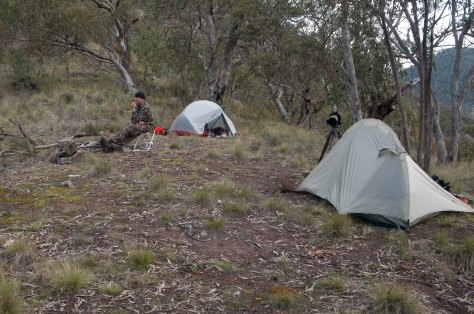
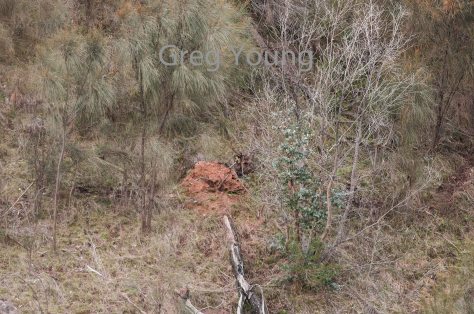

Glassing with our bino’s from the camp site soon revealed a deer. A young stag was bedded down on the opposite face quite a distance away. He was partially hidden behind a mound of earth -we could only see his head protruding to the side. We quickly set up our campsite, donned our day packs with torch and snacks, and set out to try and get a closer look. It took us over an hour to get directly opposite the stag. He was still bedded down, which was unusual given it was 5.30PM! After some stalking through a patch of Casuarina we managed to close the gap to 120 metres before he sensed our presence, became unsettled and moved off. I was lucky to get a photo as he stood up. By this time the sun was setting. Having dropped a few hundred metres in altitude from our camp, down rocky escarpments and through steep gullies, it wasn’t until well after dark when we returned back to base. Travelling during the night is when our GPS proved itself once again and I’m sure it saved us considerable time. We were both exhausted after our big day and questioned whether we had crammed too much in. However, we couldn’t resist the urge to get a closer look at this stag!

The next day, after a leisurely start, we explored along the river. We saw a few deer during the day but nothing worth following up. On the third day we walked for miles up a tributary and through some interesting and promising country, however it didn’t produce as much as we were hoping. We got honked at in the morning, watched two hinds for a while wandering around on a distant face near midday, and later stumbled onto a small stag bedded down in a rocky spur on the way back that afternoon. I wasn’t quick enough with the camera as he quickly dropped down behind low scrub and rocks. We later filled up our water bladders at a side creek before the steep climb back to camp.
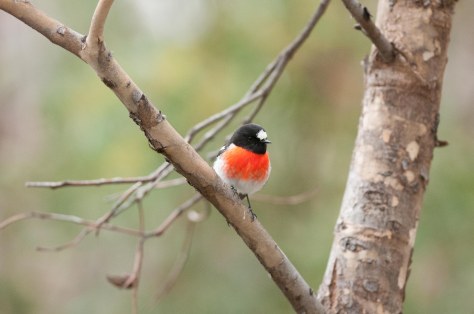

On day four we dropped down to the river just after daybreak and were pleased to observe a number of deer on the opposite face across the river. I reckon they had returned from a nightly feed on our side of the river.

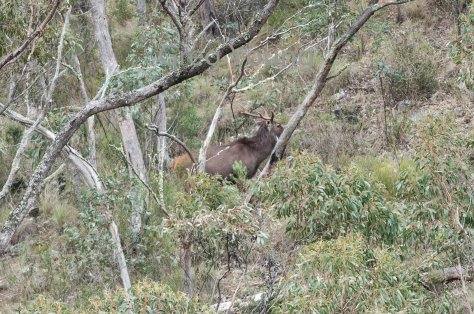
We noticed two stags well apart from each other along with a number of separate hinds. The farthest stag was 250 metres away with the closer stag half that distance. All I could see of the closer stag was the rear section of its body with its head obscured by a tree. In an effort to get a better photo I sidled to the left. I knew this was risky as deer can easily pick up lateral movement. The safest technique to get closer to a deer is in a straight line between you and the animal. However I had no choice but to go sideways in what was fairly open country. I eventually got to a good position for a photo. No sooner had I clicked the shutter I noticed a flash of a much bigger Sambar with large antlers about 10 metres behind the younger stag. Obviously the more mature animal was keeping watch for danger from the safety of cover. When it identified me and felt threatened it took off. I was hoping it would cross a couple of open clearings on its departure but being as smart as it was it kept to a narrow strip of thick vegetation as it climbed its way up the face, with the younger stag following. We crossed the river and gained some height but did not pick them up again. It’s always much more difficult stalking when you’re on the same face as the deer.
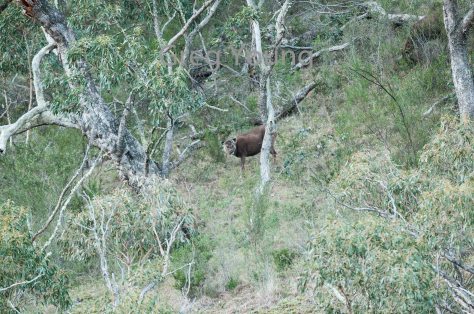
After a few hours walking we gained some altitude as we headed into a new gully system with steep faces reaching up to the clouds. There were a series of sweeping horizontal rock fault lines making the terrain all that much more challenging. We separated and kept in touch via our two way radios. Our intention was to poke our way along the side of the face hoping to see some animals. That was until Doug said on his radio “I’ve just spotted a hunter on the opposite face”. Doug at this stage was a few hundred metres above me. After a few minutes of searching I picked up a hunter wearing a blaze orange hat and Moroka 30 half blaze hunting shirt. He must have been at least a kilometre away as he was just a dot on the landscape. If it wasn’t for a couple of deer we were keeping an eye on in the general location of the hunter we wouldn’t have spotted him. We then noticed another hunter following the same line about half a kilometre behind the first hunter. They were well ahead of us on the opposite face heading in the same direction. We heard a few deer honk well up ahead so they had obviously caused alarm amongst some of the deer. Soon after the first hunter left our field of view we heard a shot. It must have been from the first hunter as we were watching his mate at the time. We then made the decision to turn around, not knowing if the other hunter was successful or not.
It doesn’t matter where you walk in the Victoria High country these days you are never far away from deer hunters. More and more hunters seem to be back packing into remote areas in search of a good hunting experience. This part of the Alpine National Park is open to hunting 10 months of the year. Even though I am taking pictures I am concerned about my safety and always wear a high vis blaze orange hat in this back country.
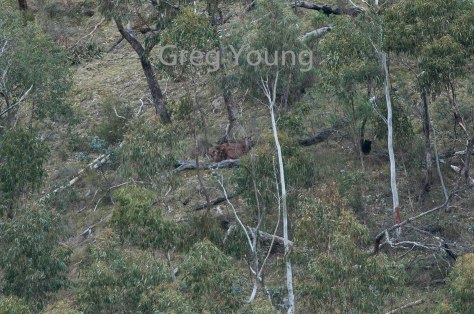
Something we heard nearly every day on this trip was wild dogs. We were hoping to catch sight of them but they were too smart for us. I remember one afternoon, as we were watching a couple of hinds bedded down, the dogs situated less than 400 metres at an angle away from the deer (and us) started howling. It was interesting to see their reaction to the dogs. I was expecting the two deer to get up and get some distance from the dogs; however they stayed where they were. After 5 mins of howling the dogs went quiet. The Sambar were still bedded down! I can only surmise that they were used to living in proximity with wild dogs and because they were fairly mature size Sambar, did not see the dogs as a threat.
The advantage of this type of country is that you can spot Sambar a good distance away, but stalking close enough for a good sharp picture is often not practical due to the difficult terrain. I found that once you get on the same face as the deer you need everything in your favour including visual contact and a quiet approach. Getting closer than 100 metres is rare. The normal situation is to have a river, creek or gorge between you and the deer, which can take more than an hour to cross. By that time the deer have moved on. This country is more suited for long range photography.

Another very enjoyable trip. It was very physically demanding but well worth the effort.
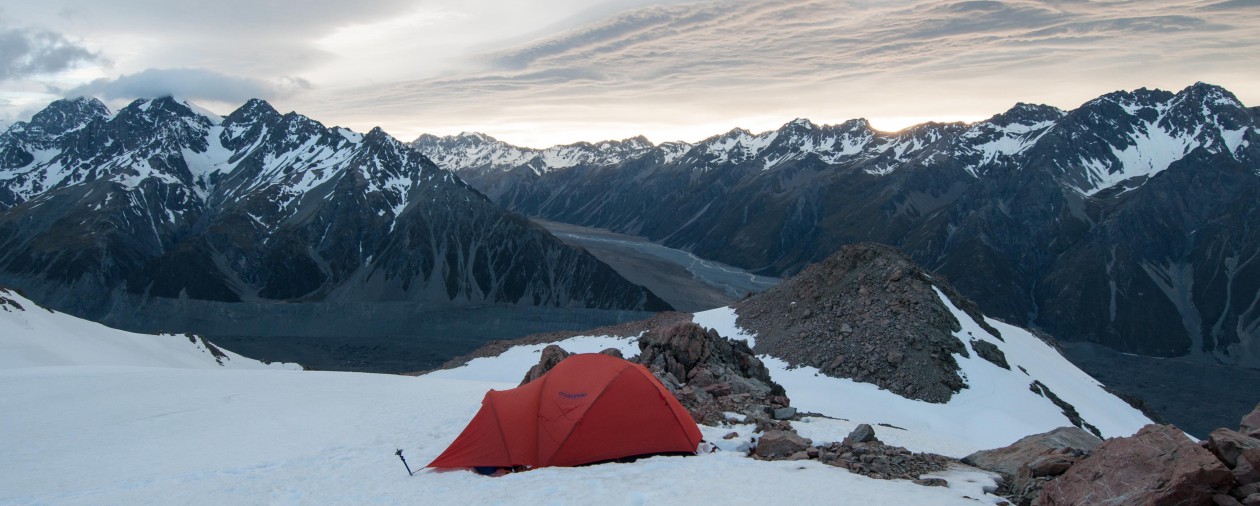

Great story Greg ….photos are fantastic !! Thanks for sharing your experience and your expertise 😊
LikeLike
Thanks Pindy. I was also grateful for Doug sharing his twisties and boiled eggs with me, that he somehow managed to pack in! Greg
LikeLike
Fantastic story, well done
LikeLike
Thanks Pat.
LikeLike